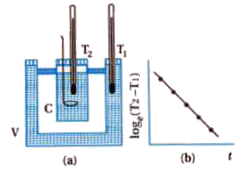State Newton's law of cooling verify with an experiment. Solution in Tamil
(i) It states that the rate of cooling of a body is directly proportional to the temperature differ between the body and the surroundings.
(ii) Consider a spherical calorimeter of mass m whose outer surface is blackened. It is filled with hot water of mass m, the calorimeter with thermometer is suspended from a stand.
(iii) The calorimeter & the hot water radiate heat energy to the surrounding. Using a stop clock, the temperature is noted for every 30 second interval of time see the temperature falls by about 20∘C. The readings are tabulated.
If the temperature falls from T1 to T2 in t sec, the quantity of heat energy lost by radiation Q=(ms+m1s1)(T1−T2), where 'S' is the specific heat capacity of the material of the calorimeter & S1 - specific heat capacity of water.
Rate of cooling = Heat energy losttime tn
∴QE=(ms+m1s1)(T1−T2)t
Room temperature - T0
(v) Average excess temperature of the colorimeter over that of the surroundings = T1+T22−T0
(vi) Acceleration to Newton's law of cooling Qt∝(T1+T22−T0)
(vii) Assume the pressure of the gas remains constant during an infinitesimally small outward displacement dy then work done dW−F.dx=P.A.dx
dW=P.dV
(viii) Total work done by the gas from volume V1 to V2 is
W=V2∫V1P.dv
(ix) But PVγ = constant (k)
γ=CPCV
∴W=V2∫V1kVγdV=k[V1−γ1−γ]v2v1 [∵P=kVγ]
∴W=k1−γ[V1−γ2−V1−γ1]
W=11−γ[kV1−γ2−kV1−γ1]
P2Vγ2=P1Vγ2=k
(x) Subtract the value of k
∴W=11−γ[P2Vγ2,V1−γ2−P1Vγ1,V1−γ1]
W=11−γ[P2V2−P1V1]
It T2 is the final temperature of the gas in adiable expansion, then
P1V1=RT1,P2V2=RT2
∴W=11−γ[RT2−RT1]
This is the equation for the work done during adiabating process.
Topper's Solved these Questions
- KINETIC THEORY OF GASES Book:SURA PUBLICATIONChapter:KINETIC THEORY OF GASES Exercise:NUMERICAL PROBLEMS
Explore 16 Videos
- KINETIC THEORY OF GASES Book:SURA PUBLICATIONChapter:KINETIC THEORY OF GASES Exercise:ADDITIONAL QUESTIONS (MULTIPLE CHOICE QUESTIONS) :
Explore 19 Videos
- KINETIC THEORY OF GASES Book:SURA PUBLICATIONChapter:KINETIC THEORY OF GASES Exercise:SHORT ANSWER QUESTION :
Explore 22 Videos
- KINEMATICSBook:SURA PUBLICATIONChapter:KINEMATICSExercise:Creative Question (HOTS)
Explore 12 Videos
- MOTION OF SYSTEM OF PARTICLES AND RIGID BODIESBook:SURA PUBLICATIONChapter:MOTION OF SYSTEM OF PARTICLES AND RIGID BODIESExercise:VALUE BASED QUESTIONS
Explore 2 Videos
Similar Questions
A fresh air is composed of ntirogen N2(78%) and oxygen O2(21%). Find the rms speed of N2andO2 at 20∘C.
View SolutionKinetic theory explains the behavior
View SolutionWhat is the microscopic origin of pressure?
View SolutionFind the speed of the projectile when it hits the ground.
View SolutionDhivya was a talented cyclist. She used to go to school in her bicycle presented by her Dad. She used to ride faster, as she always goes late from home. When she was going by the road one day. She skid down from her cycle and got injured. That was a curved road where she has to take a turn, and as she was in hurry, this incident has happened. Why does Dhivya skid from her cycle ?
(i) What is the condition for skidding ?
(ii) Derive an equation for the Angle for safer riding.
View Solutionन्यूटन के तृतीय गति नियम को लिखकर उसे एक प्रयोग द्वारा सत्यापित करें।
View SolutionState and explain Newton's law of cooling.
View SolutionState Newton's law of cooling.
View SolutionState Newton's law of cooling verify with an experiment.
View SolutionDiscuss the experiment verifying Newton's law of cooling.

View SolutionState Newton's law of cooling. Express it mathematically
View SolutionState and give mathematical expressions for Newton's law of cooling
View SolutionState Newton's law of cooling.
View SolutionState Newton's law of cooling?
View SolutionState Newton's law of cooling.
View Solution

